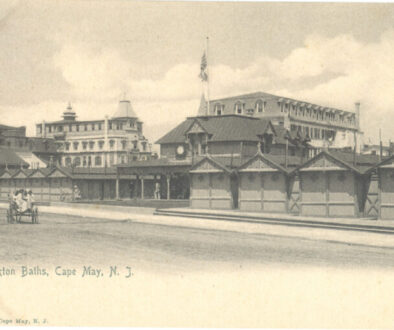A Sea Change: The challenge of rising oceans to Cape May’s future
Less than a year after Superstorm Sandy slammed into the New Jersey coast in 2012, wreaking $50 billion in destruction across the New York-New Jersey region, the Rutgers Climate Institute issued its State of the Climate Report 2013. Its sobering conclusion, in a nutshell: that Sandy was a warning, and that things could get much worse. Thanks to global warming, the water that surrounds Cape May County is about to get a lot angrier.
Since then, a series of scientific reports from federal and state agencies and from New Jersey-based research groups—including those at several area universities—have all agreed that the Jersey shore is almost certain to face ever-higher sea levels, starting a few decades from now. By the end of the century, those levels might be high enough to be considered catastrophic.
For some, hearing about something that is decades away means that they don’t have to think about it. And the end of the century? It might as well be a million years from now, one could argue. But for a town that prides itself on history, and boasts a sparkling array of Victorian homes well over a hundred years old, history is a living, breathing thing. For residents of and visitors to Cape May, taking the long view ought to be second nature.
And for Cape May, the long view is a troubling one. Over the past several years, and in plans still in development, the City of Cape May—like other towns along the Jersey shore and up and down the East Coast—are beginning to take steps to prepare for rising ocean levels. But a serious and sustained effort is urgently needed, and even then, the future looks, well, dire.

We all know the interlocking factors that contribute to sea level rise.
First, rising world temperatures, triggered by carbon emissions, are melting the Arctic and Antarctic ice. That itself leads to a gradual but steady increase in sea level. And because existing ice reflects sunlight back into space, the glaciers and ice caps help cool the planet. As they shrink and retreat, it means that the earth absorbs even more sunlight and heat.
Next, a warming ocean expands as its temperature rises, accelerating the rate of sea level rise.
And finally, New Jersey could be especially hard hit because, as the seas rise, the land here is also sinking. Part of the reason we’re sinking statewide is because we’re using lots of ground water, which leads to the land slowly losing elevation. Plus, we’re suffering from a millennia-long echo of the Ice Age: many thousands of years ago, as enormous glaciers covered the central part of North America, the sheer weight of all that ice depressed the U.S. heartland and buoyed the coasts. But, now that the glaciers are gone, the reverse is happening, and coastal North America is seesawing down again.
Concluded the 2013 Rutgers Climate Institute report: “By 2030, sea level is projected to rise by seven to 16 inches, with a best estimate of ten inches. In 2050, the range is 13 to 28 inches, with a best estimate of 18 inches, and by 2100 the range is 30 to 71 inches with a best estimate of 42 inches.”
It’s a sobering conclusion for people who live in a community at the mercy of Mother Nature’s most powerful force, the sea. “Even if the most conservative of these projections materialize, the implications for coastal flooding will be substantial.” Of course, if the least conservative estimate proves to be true, by 2100 the ocean could be nearly six feet higher than today.
People who live in Cape May well know that flooding during big storms, from hurricanes to nor’easters, is a regular occurrence. The 2009 Cape May Master Plan notes that “The low-lying barrier island is, not surprisingly, located almost entirely in the one hundred year floodplain.” But what if, thanks to climate change, a so-called “one hundred year flood” happens every few years? And, even farther down the road, if ocean levels are three or four feet higher than they are now, it’s fair to ask: Will Cape May as we know it today still be here?
For those who lived through Sandy, hanging on every word of the weather forecasters and obsessively watching the satellite images of the huge hurricane vortex as it whirled north and east, it was easy to breathe a sigh of relief after it passed. Even as coastal towns to the north were devastated, many residents of Cape May—perhaps with a touch of survivor’s guilt—were justified in thinking that we’d dodged a bullet.
But Mother Nature is still armed

A report was published last summer by the Union of Concerned Scientists, called “When Rising Seas Hit Home: Hard Choices Ahead for Hundreds of U.S. Coastal Communities.” The UCS report, prepared by a team of scientists, says that as many as 670 communities along the country’s coasts, including nearly two-thirds of those on the East Coast, could see the frequency of flooding increase from stepped-up “sunny-day” tidal flooding to what UCS calls “chronic inundation.” By chronic inundation, the study means flooding that occurs at least 26 times a year—in other words, every two weeks.
The UCS study—which helpfully includes maps of New Jersey that show precisely which areas, including Cape May, could be under water by 2100—uses low, intermediate, and high (or worst case) projections for its conclusions about what’s likely to happen. That’s because the science that underpins our understanding of global warming depends on a wide range of factors, many of which are unpredictable. And it also depends on what steps are taken around the globe to reduce the output of so-called greenhouse gases.
But virtually all of the studies on the subject agree that a steady increase in sea levels around the world is certain. And they agree that even if the United States, along with other world powers, drastically reduced carbon emissions immediately, there’s enough carbon already in the atmosphere that, for the next century at least, we’re guaranteed to have to struggle with the growing effects of climate change.
With that in mind, let’s consider what the Union of Concerned Scientists says are the implications for New Jersey under its “intermediate” scenario, i.e., the Mama Bear of their three variants. Hardest hit by 2100, says the UCS report, will be 200 communities along the Atlantic coast that “include Virginia Beach, Virginia; Cape May, New Jersey; and Hempstead, New York, as well as a cluster of communities around Beaufort, North Carolina, and nearly 40 communities in Florida.” Some areas will feel the effects sooner than others.
“In the intermediate scenario, the 70 or so communities that will be newly exposed to chronic inundation by 2035 are clustered in several regions: the Jersey Shore, the mainland side of North Carolina’s Pamlico Sound, and, as today, southern Louisiana and the Eastern Shore of Maryland,” says the UCS report.
“In New Jersey, two decades of sea level rise will bring chronic disruptive inundation to Seaside Park and 14 more towns along the Jersey Shore that today rarely feel the effects of tidal flooding…. In other places, such as Moonachie, New Jersey, where chronic inundation with the high scenario is projected to cover about 55 percent of the town, seawater would make its way into densely populated neighborhoods and industrial zones.”
By mid-century the chances that a community such as Cape May will suffer from chronic inundation increase, with the result being what UCS calls “permanent inundation.” In other words, they report, “The final result, late this century and beyond, may be neighborhoods underwater.”
It isn’t just the USC saying this. The Environmental Protection Agency (EPA), in a report issued in January 2017 (“What Climate Change Means for New Jersey”) echoes the later UCS report. “Sea level is rising more rapidly along the New Jersey shore than in most coastal areas because the land is sinking,” said EPA. “If the oceans and atmosphere continue to warm, the sea is likely to rise 18 inches to four feet along the New Jersey shore in the next century.”
And a study cited by the NJDEP reinforces Kaplan’s conclusions. By 2050, New Jersey will experience a sea level rise somewhere between 13 and 28 inches. By 2100, that increases to somewhere between 30 and 71 inches.

Marjorie Kaplan, the associate director of the Rutgers Climate Institute, works closely with scientists and policymakers throughout the state, including with New Jersey’s own Department of Environmental Protection (NJDEP) in Trenton. “By 2050, which is just a little over 30 years from now, New Jersey coastal communities will likely experience between 1 and 1.8 feet of sea-level rise above year 2000 levels,” she tells Cape May Magazine. “And by 2100, without curtailing greenhouse gas emissions, this value is likely to be between 2.4 to 4.5 feet above year 2000 levels, although some emerging science indicates these estimates may be conservative and levels could be higher.”
What could that mean, especially if the higher-end estimate proves true? According to a 2016 study in the journal Nature Climate Change, it will forcibly redraw the state map. Its conclusion: More than 800,000 people in New Jersey, including nearly 80,000 in Cape May County alone, could be forced to abandon their homes by the end of the century.
Of course, it isn’t like we have to sit around and wait for the oceans to rise. There are plenty of steps we can take along the way to protect the city and its environs. And while many shore communities, including Cape May, are—to varying degrees—doing just that, it isn’t clear that everybody is getting the message.
“Some New Jersey municipalities are taking this very seriously and are referencing sea level rise in their master plans, in changes to their building codes and some have done resilience plans that are not necessarily incorporated into master plans,” says Rutgers’ Kaplan. “But not all communities are doing this uniformly.”
Larry Hajna, a spokesman for NJDEP, points out that a number of shore communities are building defense against sea-level rise without necessarily describing it as a response to climate change. Among these efforts are flood control measures, reinforced sea walls, building up dunes, planting grasses and shrubs alongside dunes, and taking other measures that help prevent storm-surge flooding and, as seas rise, reduce the possible effects. NJDEP, through publications and conferences, is working with mayors and local officials along the shore. “What we’re doing is putting tools into the hands of local governments,” Hajna tells Cape May Magazine. “And we can help them plan.”
During his last eight years in office, from 2009-2017, former Mayor Ed Mahaney was deeply involved in a wide range of county and state efforts to explore the implications of long-range climate change on the future of Cape May. “In my mind it became a priority issue, and how we addressed it was part of our outreach efforts and part of our long-term planning,” says Mahaney. “We also set up relations with a number of local colleges who have expertise in this area.” Among the steps that Cape May has taken in recent years were to update flood maps and set new standards for elevation for new construction, continue dredging and beach replenishment efforts, and—as Mahaney said in a January 2016 state of the city address—to emphasize “the priority need to plan, permit, finance, and construct hazard mitigation projects on both our oceanfront and harborfront.”
In February 2018 Mahaney, who currently serves as the secretary of the executive committee of Sustainable Jersey, a statewide nonprofit group, took part in that organization’s first-ever NJ Mayors’ Climate Summit, at which mayors of more than a dozen cities in New Jersey—including Jersey City and Hoboken—pledged that their cities would take steps to reduce greenhouse gas emissions.
“The mayors and citizens attending today’s summit are America’s new front-line leaders on climate change,” said Ed Potosnak, executive director of the New Jersey League of Conservation Voters Education Fund. “New Jersey is one step closer to being the greenest state in the country,” said Ed Potosnak.
But Mahaney is the first to admit that there’s only so much local officials can do once an inexorable increase in sea levels begins to be felt. “If you look far enough ahead, maybe you don’t have the barrier islands anymore,” he says.
Earlier this year, the City of Cape May began efforts to revise its Master Plan, led by Craig Hurless, an engineer for the city’s Planning Board. In May, Hurless told the the Cape May Star and Wave that preparations by the city for sea-level rise anticipate that high tides in 2050 will be 1.3 feet higher than today’s, on the low to moderate end of many projections. Among the efforts already underway or being planned: strengthening oceanfront bulkheads, elevating the seawall and extending the promenade to the city’s eastern edge, building up riprap along the harbor, and modernizing sewers, drainage, and flood-control systems, especially in low-lying areas. One plan under consideration would raise the height of the seawall from the current nine to 11 feet to an average of 17 feet.
Even in the relatively near term, the effect of climate change can be felt in and around Cape May in many different ways: through increasing the frequency and intensity of storms, more severe flooding, and by upending the ecology of local marsh areas and wetlands. Already, the vast Pine Barrens to the north and west of Cape May are being severely affected by warmer temperatures, more virulent pests, and the appearance of what experts on the Barrens call “ghost forests” of dead and dying trees.
And it could have economic effects, too. In addition to the increasing costs of building defenses against a rising ocean, the cost of lifting homes, and the cost of sea walls, pumping stations and other infrastructure, there’s also another economic effect, as potential home buyers begin to consider the implications of purchasing property whose long-term future might be in doubt. “There’s a real concern in the near future,” says Zack Mullock, a local businessman and activist. “Could climate change ruin a town financially before it ruins a town physically?”
Like the South Pacific islanders whose nations could be drowned and made extinct as seas rise, but who’ve emerged as a vital voice in calling for global action to combat climate change, there’s an important opening here for Jersey shore communities to do the same. “There absolutely is a role for New Jersey cities and towns, along with state government, to contribute positively to international efforts—such as the Paris Accord—to reduce the impact of climate change,” says Kaplan. “When regions work together, be they states or communities to reduce sources of emissions, by say, improving mass transit or reducing diesel emissions from trucks, they can have a collective impact that not only addresses warming, but also provides other benefits such as improved public health and quality of life. Further, by working together, communities and states send a powerful market signal that there is an economic opportunity to innovate.”



